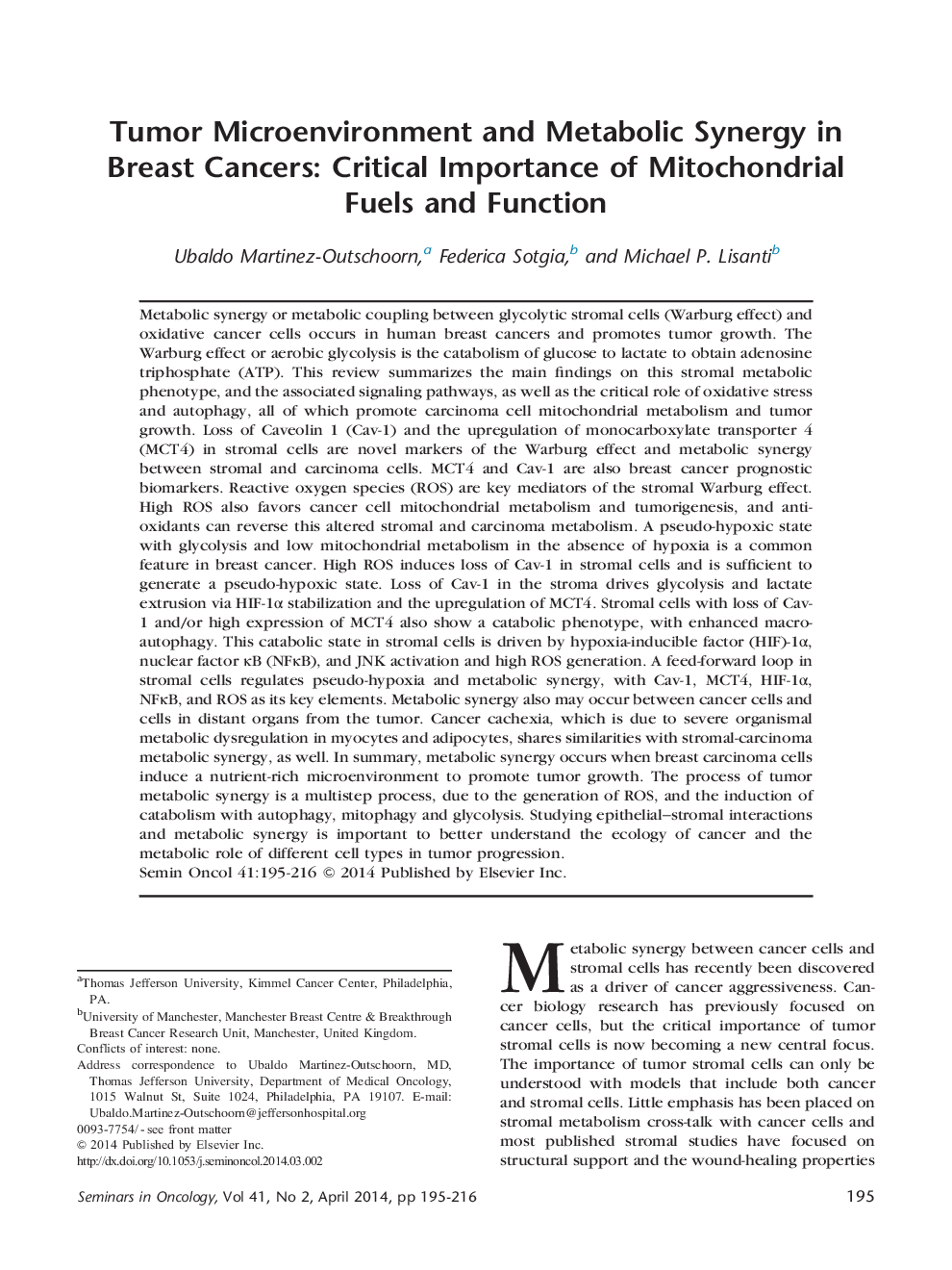| کد مقاله | کد نشریه | سال انتشار | مقاله انگلیسی | نسخه تمام متن |
|---|---|---|---|---|
| 10924339 | 1091212 | 2014 | 22 صفحه PDF | دانلود رایگان |
عنوان انگلیسی مقاله ISI
Tumor Microenvironment and Metabolic Synergy in Breast Cancers: Critical Importance of Mitochondrial Fuels and Function
ترجمه فارسی عنوان
میکرو محیط توموری و همکاری متابولیک در سرطان پستان: اهمیت بحرانی سوخت و نیروی میتوکندری
دانلود مقاله + سفارش ترجمه
دانلود مقاله ISI انگلیسی
رایگان برای ایرانیان
موضوعات مرتبط
علوم زیستی و بیوفناوری
بیوشیمی، ژنتیک و زیست شناسی مولکولی
تحقیقات سرطان
چکیده انگلیسی
Metabolic synergy or metabolic coupling between glycolytic stromal cells (Warburg effect) and oxidative cancer cells occurs in human breast cancers and promotes tumor growth. The Warburg effect or aerobic glycolysis is the catabolism of glucose to lactate to obtain adenosine triphosphate (ATP). This review summarizes the main findings on this stromal metabolic phenotype, and the associated signaling pathways, as well as the critical role of oxidative stress and autophagy, all of which promote carcinoma cell mitochondrial metabolism and tumor growth. Loss of Caveolin 1 (Cav-1) and the upregulation of monocarboxylate transporter 4 (MCT4) in stromal cells are novel markers of the Warburg effect and metabolic synergy between stromal and carcinoma cells. MCT4 and Cav-1 are also breast cancer prognostic biomarkers. Reactive oxygen species (ROS) are key mediators of the stromal Warburg effect. High ROS also favors cancer cell mitochondrial metabolism and tumorigenesis, and anti-oxidants can reverse this altered stromal and carcinoma metabolism. A pseudo-hypoxic state with glycolysis and low mitochondrial metabolism in the absence of hypoxia is a common feature in breast cancer. High ROS induces loss of Cav-1 in stromal cells and is sufficient to generate a pseudo-hypoxic state. Loss of Cav-1 in the stroma drives glycolysis and lactate extrusion via HIF-1α stabilization and the upregulation of MCT4. Stromal cells with loss of Cav-1 and/or high expression of MCT4 also show a catabolic phenotype, with enhanced macroautophagy. This catabolic state in stromal cells is driven by hypoxia-inducible factor (HIF)-1α, nuclear factor κB (NFκB), and JNK activation and high ROS generation. A feed-forward loop in stromal cells regulates pseudo-hypoxia and metabolic synergy, with Cav-1, MCT4, HIF-1α, NFκB, and ROS as its key elements. Metabolic synergy also may occur between cancer cells and cells in distant organs from the tumor. Cancer cachexia, which is due to severe organismal metabolic dysregulation in myocytes and adipocytes, shares similarities with stromal-carcinoma metabolic synergy, as well. In summary, metabolic synergy occurs when breast carcinoma cells induce a nutrient-rich microenvironment to promote tumor growth. The process of tumor metabolic synergy is a multistep process, due to the generation of ROS, and the induction of catabolism with autophagy, mitophagy and glycolysis. Studying epithelial-stromal interactions and metabolic synergy is important to better understand the ecology of cancer and the metabolic role of different cell types in tumor progression.
ناشر
Database: Elsevier - ScienceDirect (ساینس دایرکت)
Journal: Seminars in Oncology - Volume 41, Issue 2, April 2014, Pages 195-216
Journal: Seminars in Oncology - Volume 41, Issue 2, April 2014, Pages 195-216
نویسندگان
Ubaldo Martinez-Outschoorn, Federica Sotgia, Michael P. Lisanti,
